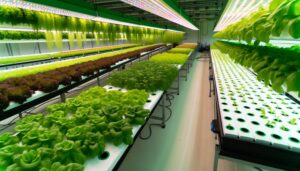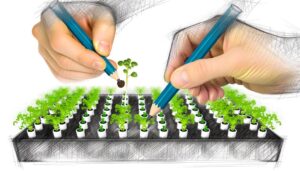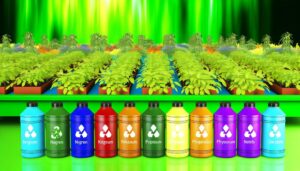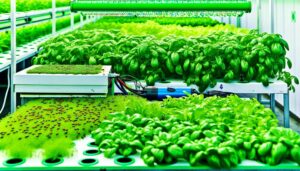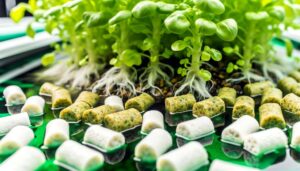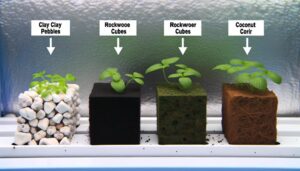How to Use H2o2 in Hydroponics
Hydrogen peroxide (H2O2) in hydroponics is essential for enhancing root oxygenation, controlling pathogens, and maximizing nutrient absorption. Use a 3% H2O2 solution at 3 ml per liter of nutrient solution for regular maintenance.
For severe contamination, increase the concentration up to 5 ml/L, ensuring accurate dilution. Apply H2O2 every 3-5 days and monitor root health for signs of over-application.
Wear protective gear when handling H2O2 and store it properly. Consistent application and precise measurement are critical for optimal plant health and disease prevention.
For detailed guidance on maintaining ideal hydroponic conditions, explore further.
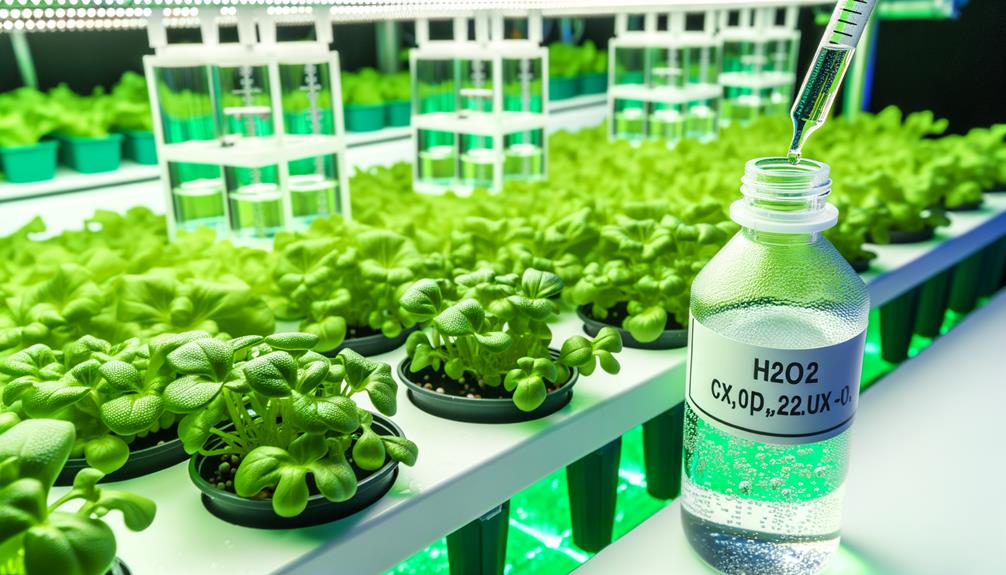
Key Takeaways
- Dilute 3% H2O2 at 3 ml per liter for regular maintenance to enhance oxygenation and prevent pathogens.
- Apply H2O2 every 3-5 days to maintain sterility and prevent disease proliferation in the hydroponic system.
- Handle H2O2 with gloves and eye protection, ensuring accurate dilution to avoid plant damage.
- Store H2O2 in a cool, dark place, away from sunlight and flammable materials, and label containers clearly.
Benefits of H2O2
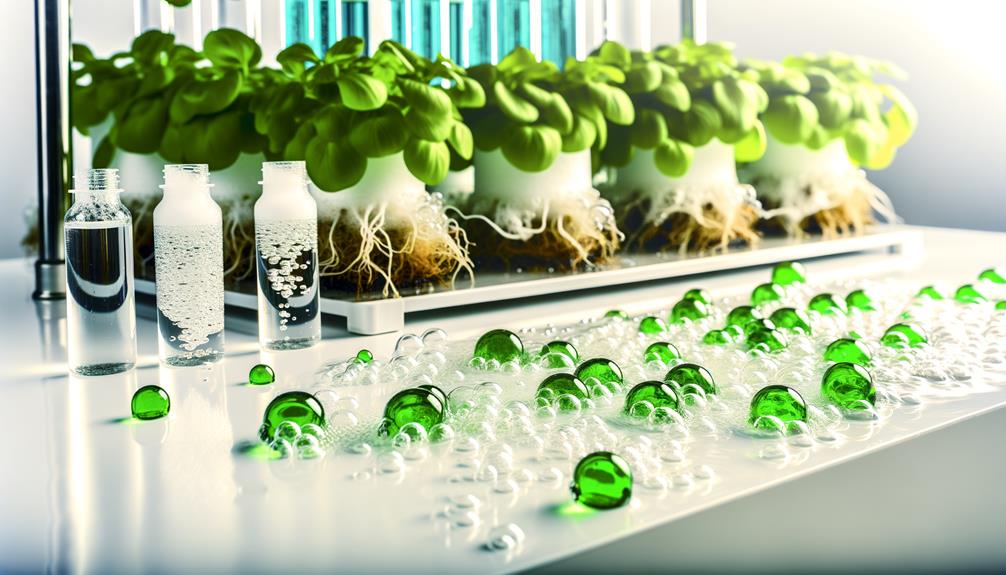
The application of H2O2 (hydrogen peroxide) in hydroponics offers several key benefits, including enhanced oxygenation of the root zone, improved disease control, and increased nutrient absorption efficiency.
The decomposition of H2O2 releases oxygen, thereby enriching the root microenvironment with dissolved oxygen. This increased oxygen availability can prevent hypoxic conditions, promoting robust root development.
Additionally, H2O2 exhibits antimicrobial properties, effectively reducing the prevalence of pathogenic organisms such as Pythium spp., which are responsible for root rot. This antimicrobial action guarantees a healthier root system, minimizing the risk of systemic infections.
Furthermore, the oxidative stress induced by H2O2 facilitates the breakdown of organic matter, thereby enhancing nutrient bioavailability and uptake. Consequently, plants exhibit improved growth performance and vigor.
Choosing the Right Concentration
Selecting the appropriate concentration of hydrogen peroxide (H2O2) is critical for maximizing its efficacy while ensuring plant safety.
Typically, a dilution ratio of 3% H2O2 to water is recommended, although specific requirements may vary based on the hydroponic system and plant species.
It is essential to adhere strictly to safety guidelines and dosage instructions to prevent oxidative damage to plant roots and beneficial microorganisms.
Optimal H2o2 Dilution Ratio
Determining the ideal dilution ratio of hydrogen peroxide (H2O2) for hydroponic systems necessitates a thorough understanding of its concentration and potential effects on plant growth and root health.
Typically, a 3% H2O2 solution is commonly used. For general maintenance, a dilution rate of 3 ml per liter of water is recommended. This ratio guarantees sufficient oxygenation and pathogen control without risking phytotoxicity.
For addressing root rot or algae, a more concentrated solution, such as 10 ml per liter, might be necessary. It is critical to mix the solution thoroughly and apply it evenly to the hydroponic reservoir.
Regular monitoring of plant response is vital to adjust dosages appropriately and avoid adverse effects.
Safety Precautions Dosage
Understanding the proper dosage and concentration of hydrogen peroxide (H2O2) is vital for ensuring both plant health and user safety in hydroponic systems.
Typically, a 3% H2O2 solution is recommended, as higher concentrations may cause root damage and oxidative stress to plants.
For general maintenance, add 3 milliliters of 3% H2O2 per liter of nutrient solution, ensuring even distribution.
When treating root rot or algae, a higher dosage of 5 milliliters per liter may be employed, but with caution and monitoring.
Always wear protective gloves and eyewear when handling H2O2, and store the solution in a cool, dark place to prevent decomposition.
Precise measurement and adherence to guidelines are essential to avoid adverse effects on both plants and users.
Adding H2O2 to Reservoir
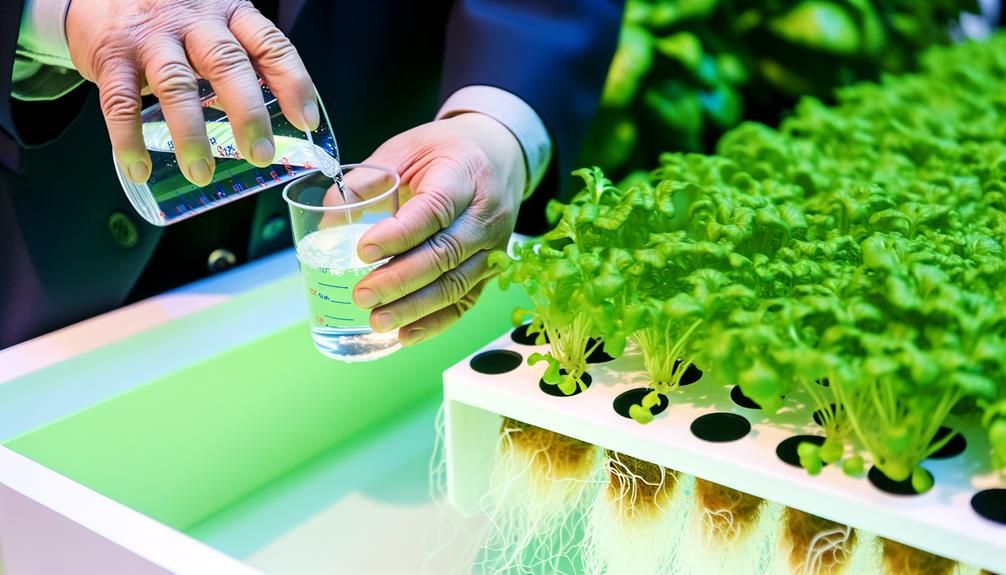
When adding H2O2 to your hydroponic reservoir, it is vital to accurately measure and dilute the hydrogen peroxide to achieve the desired concentration, typically around 3-5 ml of 3% H2O2 per gallon of water.
Utilize a calibrated syringe or pipette for precise measurement.
Before introducing H2O2, verify the reservoir water is adequately mixed by employing an air stone or circulation pump.
Gradually add the H2O2 solution to the reservoir to guarantee uniform dispersion.
Monitoring the pH and electrical conductivity (EC) of the nutrient solution is significant, as H2O2 can cause fluctuations.
Regularly test and adjust these parameters to maintain the best growing conditions.
Implementing these steps meticulously guarantees the effective integration of H2O2 into the hydroponic system. This ensures optimal oxygenation and pathogen control, promoting healthier root development and overall plant growth. Adhering to these guidelines also minimizes the risk of overuse, which could negatively impact beneficial microbes in the system. For additional insights, consider exploring DWC hydroponics usage tips to enhance efficiency and maximize yields.
Root Disease Prevention
Implementing H2O2 in hydroponic systems can greatly mitigate root disease by oxygenating the root zone and sterilizing harmful pathogens.
Hydrogen peroxide (H2O2) dissociates into water (H2O) and nascent oxygen (O), which enhances aerobic conditions unfavorable to anaerobic pathogens such as Pythium and Fusarium.
For ideal results, use a 3% H2O2 solution at a concentration of 3-5 ml per gallon of nutrient solution. This dosage guarantees microbial pathogens are effectively neutralized without harming plant roots.
Regular application, typically every 5-7 days, maintains a sterile environment and prevents disease recurrence.
Monitoring root health and system cleanliness in conjunction with H2O2 usage guarantees a robust and disease-free hydroponic setup, promoting vigorous plant growth and maximizing yield.
Enhancing Oxygen Levels
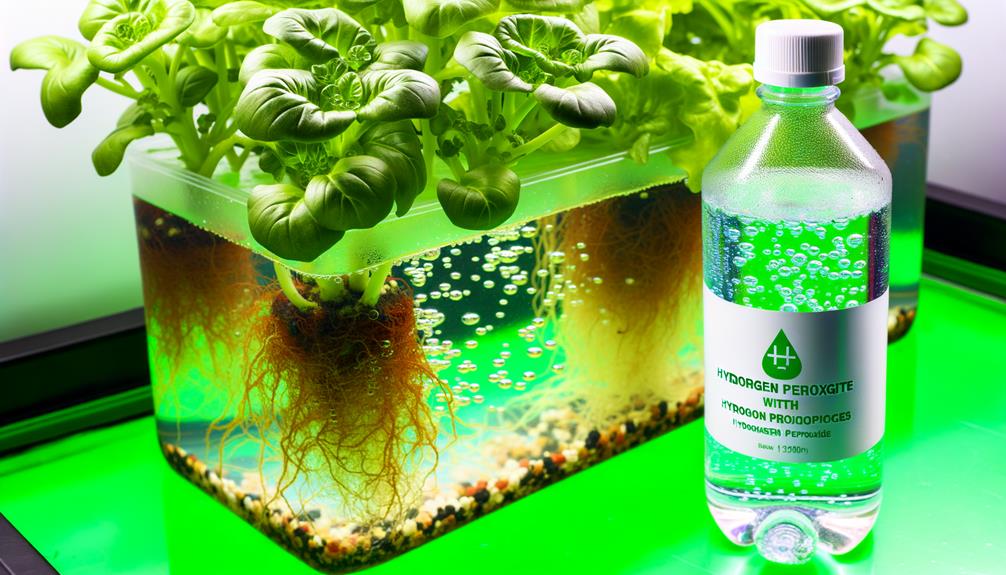
Maintaining ideal oxygen levels in hydroponic systems is essential for root respiration and overall plant health, further complementing the pathogen control benefits of H2O2.
Hydrogen peroxide (H2O2) dissociates into water (H2O) and oxygen (O2), releasing additional oxygen molecules into the nutrient solution. This process enhances dissolved oxygen content, facilitating aerobic respiration at the root zone.
To achieve superior results, integrate H2O2 at a concentration of 3-5 mL per liter of nutrient solution. Regularly monitor dissolved oxygen levels using a dissolved oxygen meter to guarantee they remain within the superior range of 6-8 ppm.
This practice not only supports vigorous root growth but also mitigates hypoxic conditions, thereby promoting robust plant development and maximizing yields.
Cleaning Hydroponic Equipment
Effective cleaning of hydroponic equipment is essential to prevent pathogen buildup and guarantee peak system performance.
Hydrogen peroxide (H2O2) serves as an effective sterilizing agent for hydroponic systems due to its potent oxidizing properties.
When cleaning, verify the following steps:
- Disassemble all components: This verifies thorough cleaning of each part.
- Prepare a 3% H2O2 solution: Suitable for disinfecting most hydroponic equipment.
- Immerse and soak equipment: Allow components to soak for 20-30 minutes to verify microbial elimination.
- Scrub surfaces: Use a non-abrasive brush to remove any biofilm or residues.
These detailed steps will help maintain a sterile environment and optimize plant health.
Correct Dosage Guidelines
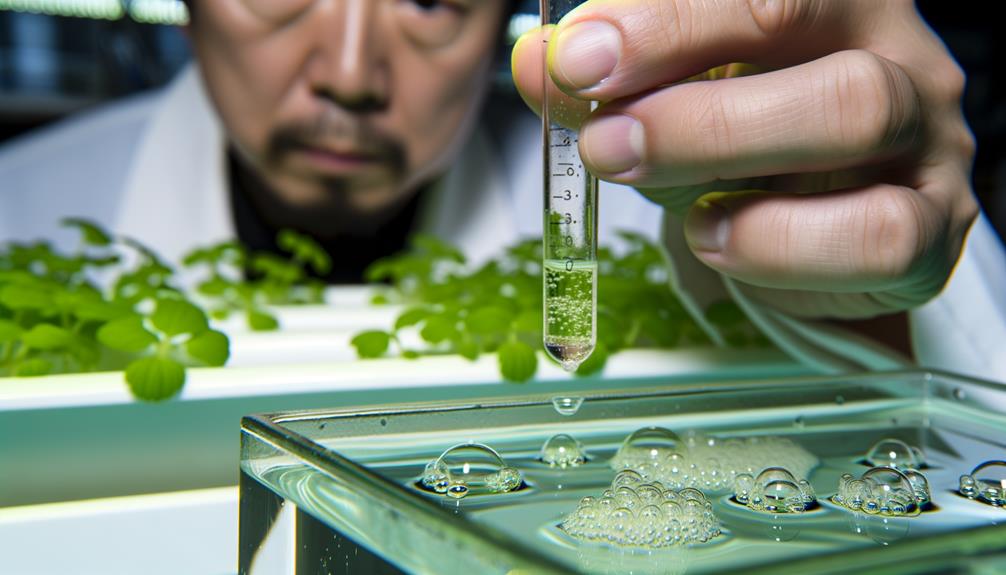
Administering hydrogen peroxide in hydroponic systems necessitates accurate measurement of concentrations, adherence to specific application frequencies, and proper dilution ratios.
Typically, a 3% H2O2 solution is used at a rate of 3 ml per liter of nutrient solution, applied bi-weekly.
Ensuring the correct dosage helps maintain ideal plant health and prevents adverse effects on the root zone.
Measuring Precise Amounts
Accurately determining the correct dosage of hydrogen peroxide (H2O2) in hydroponic systems requires a precise calculation based on the concentration of the H2O2 solution and the volume of the nutrient reservoir.
To achieve the best results, follow these guidelines:
- Identify the H2O2 concentration: Confirm whether you are using a 3%, 6%, or higher concentration solution.
- Calculate the reservoir volume: Measure the total capacity of your nutrient reservoir in liters or gallons.
- Determine the dosage rate: Typically, a 3% H2O2 solution is used at a rate of 3 ml per liter of reservoir water.
- Dilution process: Gradually mix the H2O2 into the water to guarantee even distribution.
Adhering to these steps guarantees the effectiveness and safety of H2O2 application in hydroponics.
Frequency of Application
Once the correct dosage of H2O2 has been determined, it is essential to establish a consistent application schedule to maintain ideal hydroponic conditions.
Hydrogen peroxide (H2O2) should typically be administered every 3 to 5 days to prevent pathogen proliferation and guarantee peak oxygenation of the root zone.
It is vital to monitor plant response and environmental factors, as these can necessitate adjustments in frequency. For example, higher temperatures or increased plant density may require more frequent applications.
Additionally, periodic assessment of water quality parameters such as pH and electrical conductivity (EC) is recommended to confirm that H2O2 levels remain within safe and effective ranges.
Consistent application enhances nutrient uptake and fortifies plant health.
Dilution Ratios Explained
Determining the correct dilution ratio for hydrogen peroxide (H2O2) in hydroponic systems is essential to guarantee both efficacy in pathogen control and safety for plant roots.
Proper dilution guarantees ideal oxidative properties without causing root damage. Typically, a 3% H2O2 solution is diluted at a rate of 3 ml per liter of nutrient solution.
Below are specific guidelines to achieve accurate dilution ratios:
- 1 ml/L: For regular maintenance and to prevent pathogen buildup.
- 2 ml/L: To treat minor pathogenic issues without harming beneficial microbes.
- 3 ml/L: For moderate infestations of algae or fungi.
- 5 ml/L: In cases of severe contamination requiring intense disinfection.
Adhering to these guidelines will promote a healthy hydroponic environment.
Monitoring Plant Health
Monitoring plant health in a hydroponic system involves regularly evaluating root color, leaf condition, and overall growth patterns to detect early signs of nutrient deficiencies or pathogen presence.
Root color should be a creamy white; any browning or blackening may indicate root rot or nutrient imbalance.
Inspect leaves for chlorosis (yellowing), necrosis (browning), and deformities, which can signal deficiencies in nitrogen, potassium, or other essential nutrients.
Observe growth patterns; stunted growth or wilting may suggest inadequate oxygen levels or pathogen intrusion.
Utilize tools like pH meters and electrical conductivity (EC) meters to guarantee nutrient solution parameters remain within ideal ranges.
Regularly documenting observations can aid in diagnosing issues promptly, securing robust plant health and maximizing hydroponic yields.
H2O2 Safety Precautions
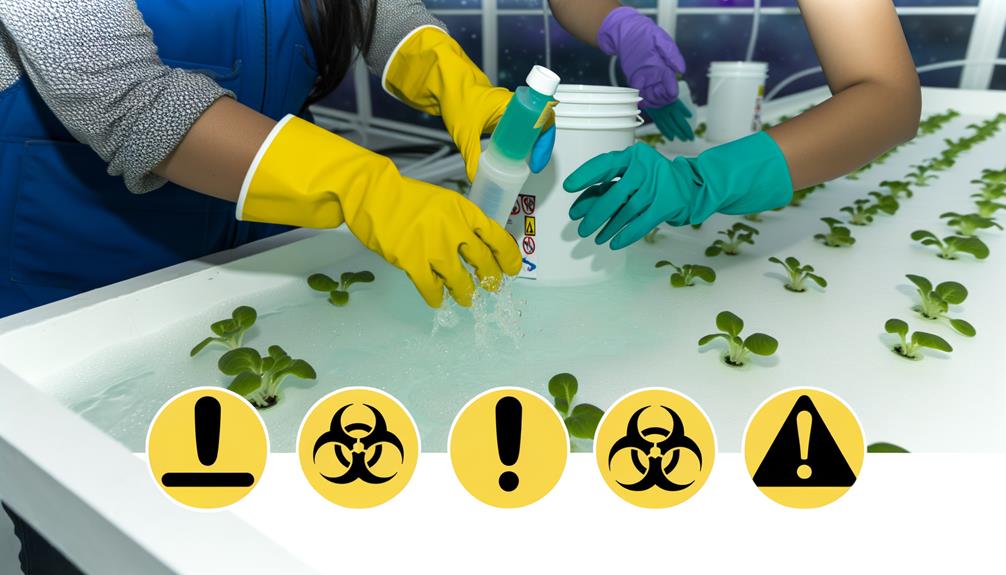
When incorporating hydrogen peroxide (H2O2) into your hydroponic system, it is imperative to adhere to stringent safety precautions to prevent potential damage to both plants and equipment. The following guidelines guarantee safe and effective use:
- Personal Protective Equipment (PPE): Always wear gloves and eye protection when handling H2O2 to safeguard against skin and eye irritation.
- Proper Dilution: Use precise measurements to dilute H2O2 accurately, guaranteeing it is at a safe concentration for plant application.
- Storage: Store H2O2 in a cool, dark place, away from direct sunlight and combustible materials to prevent decomposition and potential hazards.
- Ventilation: Guarantee adequate ventilation in the growing area to dissipate any fumes generated.
Common Mistakes to Avoid
Misjudging the concentration of hydrogen peroxide (H2O2) is a common mistake that can lead to phytotoxicity and damage to the delicate root systems of hydroponic plants.
Accurate measurement is vital; overconcentration can induce oxidative stress, while under-dosing fails to achieve the desired antimicrobial effect.
Another prevalent error is the improper integration of H2O2 into the nutrient solution. It is essential to guarantee thorough mixing to avoid localized high concentrations.
Additionally, failing to adjust for the degradation rate of H2O2 in light and heat can render treatments ineffective.
Finally, neglecting to monitor residual H2O2 levels can disrupt nutrient absorption and plant health.
Implementing precise dosing protocols and regular monitoring guarantees the safe and effective use of H2O2 in hydroponics.
Conclusion
In the domain of hydroponics, hydrogen peroxide (H2O2) emerges as a double-edged sword, symbolizing both the harbinger of purity and the guardian against decay.
Mastery of appropriate concentrations and precise application methods guarantees that this versatile compound becomes an ally in promoting robust plant health.
Vigilant monitoring, adherence to safety protocols, and avoidance of common pitfalls are paramount.
Consequently, H2O2 not only enriches oxygen levels but also fortifies the system against root diseases, fostering a thriving hydroponic ecosystem.

